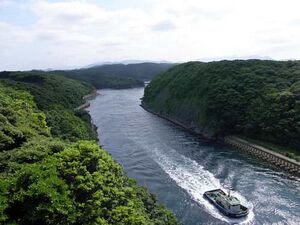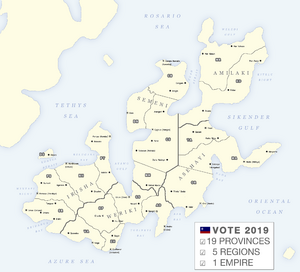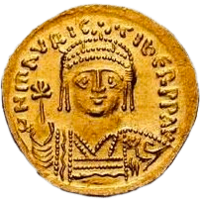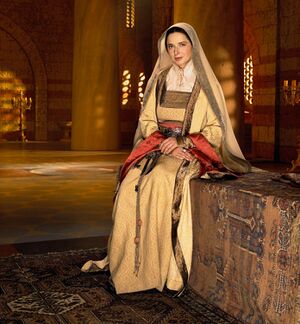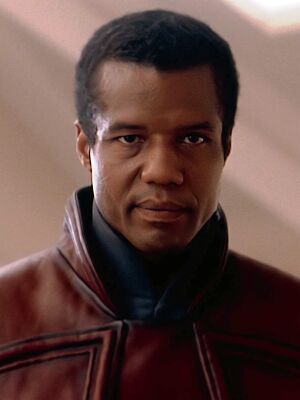Orioni: Difference between revisions
m (→History) |
m (→History) |
||
| Line 246: | Line 246: | ||
===Early dynastic rule=== | ===Early dynastic rule=== | ||
[[File:Allat Palmyra RGZM 3369.jpg|200px|thumbnail|Erwanin brings peace ({{wp|palm leaf}}) by conquering Tigrai]] | |||
The [[Meda|Medani empire]] represented the first major centralised {{wp|nation state}}. By the 18th century {{sc|bce}} the Medanese ruled the eastern {{wp|peninsula}} and adjecent coastlines, exploiting rich hinterlands as well establishing a reputation as experienced sailors. By the 11th century {{sc|bce}} their westward expansion led to a conflict with the tribal {{wp|Nairi}} confederation. | The [[Meda|Medani empire]] represented the first major centralised {{wp|nation state}}. By the 18th century {{sc|bce}} the Medanese ruled the eastern {{wp|peninsula}} and adjecent coastlines, exploiting rich hinterlands as well establishing a reputation as experienced sailors. By the 11th century {{sc|bce}} their westward expansion led to a conflict with the tribal {{wp|Nairi}} confederation. | ||
| Line 251: | Line 252: | ||
===Imperial Orioni=== | ===Imperial Orioni=== | ||
[[File:Orioni-coin-602-CE.png|200px|thumbnail|Coin of Empress Saimei (602 {{sc|ce}})]] | |||
Queen Nintoku proclaimed herself the First {{wp|Empress}} of Orioni. She merged their collective navy and promoted expansionism in order to gain more lands for its people. The Orioni empire was uniquely situated for success, along the commercial route between the [[Memopotamia]], the [[Aroman Empire]] and the Far Eastern states. The Queendom also regularly entered the politics of the kingdoms on the nearby [[Europa (continent)|Europan mainland]], establishing colonies in [[Tamurin]] and [[Pirilao]]. This created a common cultural identity with a distinctive Orinese mark | |||
The Imperial title was passed down through a matriarchal succession, from mother to daughter. At the same time, Orinese curtailed male authority, removing previous male leaders from the royal lists and making sure that no man held multiple royal titles. | |||
==Politics== | ==Politics== | ||
Revision as of 21:14, 7 October 2019
This article is incomplete because it is pending further input from participants, or it is a work-in-progress by one author. Please comment on this article's talk page to share your input, comments and questions. Note: To contribute to this article, you may need to seek help from the author(s) of this page. |
The Empire of Orioni Erwanin Emparayia (Oharic) | |
|---|---|
| Motto: Libertati Viam Facere | |
| Anthem: Freedom's Sun | |
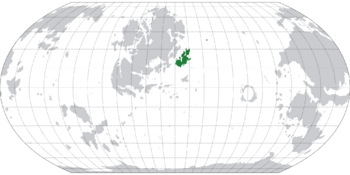 Location of Orioni on Eurth | |
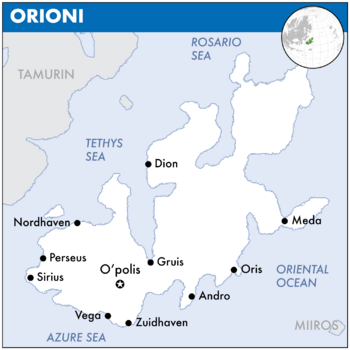 Map of Orioni | |
| Capital |
|
| Largest city | Zuidhaven |
| Official languages | Oharic |
| Recognised national languages | Anglish |
| Demonym(s) | Orinese |
| Government | Unitary parliamentary constitutional monarchy |
• Empress | Joni I Nabérrie |
• Chairperson | Chandra Pristo |
| Legislature | Sibiseba |
| Establishment | |
• Queendom | 980 BCE |
• First Empire | 536 BCE |
• Second Empire | 1175 CE |
| Area | |
• Total | 1,139,811 km2 (440,083 sq mi) |
| Population | |
• 2018 estimate | 144,800,000 |
| GDP (nominal) | 2018 estimate |
• Total | 5,632,000,000 |
• Per capita | 38,894 |
| HDI (2017) | very high |
| Currency | ION (ION (Φ)) |
| Time zone | UTC+9 to +10 |
| Antipodes | Oyus |
| Date format | dd/mm/yyyy |
| Driving side | right |
| Calling code | + |
| ISO 3166 code | OR |
| Internet TLD | .io |
The Orioni Empire, commonly referred to as Orioni (o·ri·o·ni; pronounced /ɒɹiːɒniː/ or oh-ree-oh-nee), is an island nation off the eastern coast of the Europan continent. Orioni also lies on the western side of the Oriental Ocean and stretches from the Rosario Sea in the north to the Azure Sea in the south. It is an environmentally stunning nation, ruled with a fair hand by Her Imperial Highness Joni I Nabérrie, and notable for its museums and concert halls, daily referendums, devotion to social welfare, and a keen interest in outer space.
Orioni is a democracy organised in the form of a parliamentary government under a constitutional monarchy. The constitution defines the Empress as "the symbol of the state and of the unity of the people." It is difficult to tell where the omnipresent government stops and the rest of society begins, but it juggles the competing demands of Law & Order with social welfare and equality. Its politicians meet every day in the capital city of O'polis to discuss matters of state. Orioni is a highly developed country with one of the largest economies in Eurth, supported by a strong maritime-commercial base.
Etymology
The original name for Orioni is Erwanin. It literally means "land of the lady". Erwa means "land" in Indo-European. In the ancient Memopotamian cuneiform script, the term Nin was used to denote a queen or lady. Other languages use a version of Na or Ma. With Orioni being a matriarchal monarchy, this created the name Erwa-Nin, or "land of the queen lady".[1]
The oldest mainstream source for the name is Parhevdi X. Originally, according to transcribed oral traditional, there were five septs living in the O'polis area on the Altais Plateau: the Anidenya, the Huletenya, the Sositenya, the Aratenya and the Amisitenya. Other clans from the lower coastal land to the south and from the rulers of Tigray province to the east, a part of the Medani empire, frequently attacked these towns. The women of each sept decided that the five septs must unite to defeat their common enemy and preserve peace. The men accepted this decision, giving credence to the name "Erwanin".
The name Erwanin also contrasts with mainland Europa, which is dominated by patriarchal societies using the honorific of "baba" or "father". Orinese referred to these other lands as "Land of the Father" or Erwa-Ba(b), over time evolving over Eruaba to present-day "Europa".
The name also appears in other languages under several forms:
- Arauni. In the 9th century BCE, the ancient Suhrabians referred to the nation as Aranu, and the nearby Afropans called them Arauni. The Sahrabic name "Ari" comes from "Aruin".
- Uru-anna. Other experts have suggested that Orioni originated from the Hakadian Uru-anna, "the light of heaven", the name then passing into Aroman mythology as Ὠρίωνί.
- Urania. The most distinctively Western Oriental title is Urania, the Semitic "queen of the heavens". This reference to a lunar goddess probably signifies "she whose seat is in heaven", from which she exercises her sway over the known world—earth, sea, and air alike.
- Haryana. The name Haryana is found in the works of the 12th-century AD Apabhramsha writer Vibudh Shridhar (1189–1230). The name Haryana has been derived from the Sanskrit words Hari हरि (the Hindu god Vishnu) and Ayana अयन (home), meaning "the Abode of God". However, scholars such as Muni Lal, Murli Chand Sharma, HA Phadke and Sukhdev Singh Chib believe that the name comes from a compound of the words Hari (Sanskrit: Harit हरित्, "green") and Aranya अरण्य (forest).
- Urin. The Alemmanic languages follow a different approach, pronouncing the name as "Urin". This is short for "Urinsel", a compound of ur- "original" and Insel "island". This linguistic term denotes the hypothesised prehistorical homeland of some Alemmanic clans.[2]
- Hariwini. Another Alemmanic source claims the name originated from Hariwini, composed of the elements hari "respected" and win "friend".
- Porane(k). The Salvic languages use the word porane(k) to describe the morning. In Salvic mythology, Porane is a guardian goddess who opens the gates each morning so that the San may begin its journey. She is a patroness of horses, protection, healing, and the planet Venus.[3]
Geography
Orioni is an island nation in the east of Europa, separated from the Europan mainland by the Tethys Sea; south of Ide Jima, separated by the Rosario Sea; and north of Niederoestereich, separated by the Azure Sea. The closest neighbouring country to Orioni is the Tamurin republic westward across the Roavia Strait.
The main island is also the "Home Island". This island is divided into three parts: western Alnitak where the majority of the Orinese population lives, central Alnilam is dominated by the Oromiyaa massif and plateau, and northeastern Almintaka forms a sparsely inhabited nature preserve. Besides the main island, there are also 430 smaller islands, of which the larger ones are being inhabited and others remain uninhabited.
Maritime claims:
- Continental shelf: 200 m depth or to the depth of exploitation
- Territorial sea: 12 nautical miles (22,2 km or 13,8 mi)
- Exclusive economic zone: 200 nautical miles (370 km or 230 mi)
Landscape
About 53% of Orioni is forested, mountainous and unsuitable for agricultural, industrial, or residential use. Hill country of over 500 m above sea-level dominates the home island, and in some other elevated regions even 2000 m. Coastal areas contain the habitable zones and have high population densities. As a result, Orioni is one of the most densely populated countries in the world.
The western part of the country contains temperate forestland and rolling hills, with a strong agricultural imprint on the northern plains and along the Firigirigi river. The Wenizi river flows through the western part of the country, it's origin located somewhere in the high mountains of towards the east. The artificial Owara canal connects the Wenizi with the Firigirigi, enabling shipping to multiple parts of this western region. The canal was built in 1671 by decree of Empress Owara and modernised in around 1900. Between 1895 and 1904, the army engineers enlarged the Owara canal to 25 metres (82 feet) wide and 3 metres (9.8 feet) deep. Empress $name expanded the canal again to 40 metres (130 feet) wide and 4.5 metres (14.8 feet) deep through mountainous rocky terrain.

In the east and south, along the shores of the Azure Sea, are extensive and densely populated alluvial plains of the Wenizi and the Caroni river, combined with lower mountain ranges in the Zinabi valley to the east. This fertile valley in the southeastern part of the country is curtailed by the Dayonisesi mountains, a mountain range that forms an enclosing arc, and also contains the countries highest point, Mount Oromis at 4802 m.
The northeastern region of Orioni consists of elevated highlands call the Oromiyaa massif and plateau.
Climate
Orioni has a tropical maritime climate that is usually hot and humid. There are three seasons: the hot dry season or summer from March to May; the rainy season from June to November; and the cool dry season from December to February. Temperate easterly winds and southern ocean currents ensure warm summers and very mild winters. Seasons vary per region, with the south being warmer compared to the rainy west and subtropical north. Temperatures usually range from 21 °C (70 °F) to 32 °C (90 °F) although it can get cooler or hotter depending on the season. The coolest month is January; the warmest is May.
The average yearly temperature is around 26.6 °C (79.9 °F). In considering temperature, location in terms of latitude and longitude is not a significant factor. Whether in the extreme north, south, east, or west of the country, temperatures at sea level are in the same range. Altitude usually has more of an impact. The average annual temperature on the Oromiyaa massif and plateau at an elevation of 1,500 meters (4,900 ft) above sea level is 18.3 °C (64.9 °F), making it a popular destination during hot summers.
Fauna and flora
The pink dolphin (Inia geoffrensis), which frolics freely in the nation's sparkling rivers, is the nation's national animal. They are solitary animals and live primarily in the southern river systems of the Wenizi and Caroni. Pink dolphins are unique among dolphins for having molar-like teeth and can chew their prey. Diet of Orioni river dolphins comprises fish, shrimps and crabs. They also eat piranhas and turtles. Pink dolphins are true carnivores (meat-eaters). Pink dolphins can move from rivers to ponds and lakes during the rainy season (when rivers flood). Some pink dolphins are actually very rare albinos. Albino dolphins can appear pink instead of white because of the blood vessels under their skin.
The southeastern mountain flanks enjoy a nice climate that allows for vineyards to grow. Lush broad-leaved trees in the northern forest. These lush green giants cover most of the country.
Administrative divisions
The bureaucratic administration of Orioni is divided into four basic levels. Following the Nomenclature of Territorial Units for Statistics (NUTS), these levels are: country, region (NUTS-1), province (NUTS-2), and municipality (LAU). Below the national government, there are 5 regions, further divided into 19 provinces. These regions do not have elected officials, nor are they corporate bodies. But the practice of ordering provinces based on their geographic region is traditional.
- Weriki (central) forms the core of the empire, with its ancient traditions and ageless monuments. It is the geographic location of the first septs that banded together before politically uniting the entire island.
- Asehayi (east) is geographically similar to the central region, but it is less populous because of the more arid climate. The rough inland geography encourages a more seaward attitude.
- Irisha (west) has always followed a more continental approach, influenced by its proximity to the Europan mainland across the Tethys Sea. It is agriculturally important thanks to the fertile land of the Western Plains.
- Semeni (north) is the most mountainous region, dominated by the Oromiyaa massif and plateau. Rich in minerals, its mining enterprises provide most resources for the nation's industrial activity. The many rivers and coastal roads enhance accessibility, supported by a railroad network along the coast.
- Amilaki (northeast) is the least populous region. Most of the area is part of the Europan Wildlife Reserve established by EOS.
From north to south, the provinces of Orioni and their commonly associated regions are:
During the 20th century, Orioni claimed numerous neighbouring countries and regions in Europa, Thalassa and Marenesia were "lost provinces" of Orioni. Many of these "lost provinces" were under the rule of Imperial Orinese dynasties or were former tributary states. Empress $name claimed in $year that these provinces were lost because of unequal treaties, forceful occupation and annexation, and foreign interference. These former provinces include Rohini, Burkini, the outlying islands of Miiros.
History
Prehistory
Archaeological evidence suggests that prehistoric humans related to Marenesian Aborigines inhabited Orioni from 8000 BCE. Wall paintings of the Arcana culture were found at the archaeological site of Arcan on the southern side of the Altais mountains in western Orioni, where thousands of objects were discovered in 1857. Decorated pottery was dated to be from about 6500 to 5300 BCE.
Sometime during the late the 5th millennium BCE, the Amari people settled in Orioni, arriving from the east and spreading across the entire island. The Amari weren't native to the Orioni islands. By 4800 BCE, they are believed to have become the politically dominant ethnic group. Early Amari residents lived in mud-brick houses, stored their harvest in granaries, and created a system of roads radiating out from their great house sites.
By 1800 BCE major port cities started to form on a long and narrow strip along the Azure Sea. The early city-states never constituted one political unity, but likely shared a cultural identity between the peoples based on a common language. Each major city was ruled by a monarch in cooperation with representatives of merchant families.
Early dynastic rule

The Medani empire represented the first major centralised nation state. By the 18th century BCE the Medanese ruled the eastern peninsula and adjecent coastlines, exploiting rich hinterlands as well establishing a reputation as experienced sailors. By the 11th century BCE their westward expansion led to a conflict with the tribal Nairi confederation.
According to transcribed oral traditional, Lady Anahita of newly-formed Erwanin queendom halted the Medanese expansion by warring against the Medanese province of Tigrai. The takeover of Tigrai goldmines led to increased wealth and access to the rich coastal port of Ophir. Her descendants expanded the early Erwanin territory towards along southern coasts, into western lands and finally into the east. More provinces of the weakened Medanese dynasty were subjugated, and in 536 BCE Medanese capital itself was conquered by Erwanin.
Imperial Orioni
Queen Nintoku proclaimed herself the First Empress of Orioni. She merged their collective navy and promoted expansionism in order to gain more lands for its people. The Orioni empire was uniquely situated for success, along the commercial route between the Memopotamia, the Aroman Empire and the Far Eastern states. The Queendom also regularly entered the politics of the kingdoms on the nearby Europan mainland, establishing colonies in Tamurin and Pirilao. This created a common cultural identity with a distinctive Orinese mark
The Imperial title was passed down through a matriarchal succession, from mother to daughter. At the same time, Orinese curtailed male authority, removing previous male leaders from the royal lists and making sure that no man held multiple royal titles.
Politics
Monarchy
The head of state has always been a member of the imperial family. Leadership passes on via matriarchal blood ties: it’s inherited from mother to daughter, sister or niece. Note that the empress does not always have to die to pass on the title; old age or illness are also reasons. For as long as Orioni existed, there has always been a woman to lead them. The empress receives the honorary title of “Orioni”, representing a personification of the entire country by a single person. The current monarch came to power at a rather young age because of the sudden and unexpected death of her mother on March 1st, 2003.[4] Since then, the young royal had a turbulent time learning to balance on the ropes of the international scene. Aristocracy removes a few select individuals from the daily economic competition in order to raise them for the office of government. These responsibilities demand an extraordinary education that no conventional education can give. As such, the aristocracy is a garden for government, a repository for rulers, a cradle for culture. It works as a conservative force against short-term fads or erratic variations in the moral code.
Government
The government is organised into three significant levels: national (imperial), provincial (Oharic: Kifile), and municipal (Oharic: Kibite). Elections happen every 5 years for each of these levels of government. In the 2015 election for the Sibiseba the most popular party was the SPO which won 46% of the vote. The next four most popular parties were Blueropa (35%), Pink! (12%), the PO&N (5%), and the Fronde Verdur (2%). In the national election, a total of 103.966.194 votes were cast (out of 80,34% voting age population), and the voter turnout was 89,37%. Provincial autonomy is extensive. The Imperial level takes command of most international affairs such as defence, commerce and foreign affairs.
The government comprises three branches of government. These three branches apply checks and balances on each other.
- Legislative branch. The Sibiseba (Anglish: Assembly) serves as the legislative body of the Orioni Empire. It is a unicameral system. The Sibiseba exists as the peacekeeping body between the different provinces within the Empire. The Sibiseba votes on provincial disputes brought before it based on what is best for the whole population. During the 19th century, the Sibiseba's powers came to include all important matters of state, including its representation in international organisations, declarations of war against an enemy, and offering military and technological aid to an ally. Each Sibisebali represents a single constituency within the empire. Each Sibisebali serves a four-year term. The number of constituencies is re-evaluated before each election, thus altering the number of Sibisebali every four years. The 1923 Constitution instituted the membership by right (senator de drept) in the Sibiseba for: the heir to the throne; heads of state-recognised religious bodies; the president of the Andro Academy; former chairpersons of the Imperial Council; former councillors with at least five years’ seniority; former judges of the Palace of Justice; retired generals.
- Executive branch. The Imperial Council (Oharic: Memakiriti) holds imperium, "the power to rule", and is the ruling body of the executive branch. The council informs the Monarch on policy matters. The council comprises twelve councillors, chaired by 1 chairperson, and divided over three topical sub-councils. It meets to discuss matters of state in the capital city of O'polis. After each election, the winning parties form a coalition government and appoint an executive cabinet. Chairlady of the Council is Dr. Chandra Pristo. She is a former anthropology professor and leader of the SP.o, the largest political party.
- Judicial branch. The highest court is the Palace of Justice, which comprises twelve justices. The court deals with imperial and constitutional matters and can declare legislation or executive action made at any level of the government as unconstitutional, nullifying the law and creating a precedent for future law and decisions. Below the Palace of Justice are the Halls of Justice, and below them are the Houses of Justice, which are the general trial courts of law. The judicial branch organises on a scale equal to the three levels of government (imperial, provincial, municipal).
Political parties
The legislative branch of government comprises many political parties, be they centrist, progressive, conservative, nationalist or other. These parties form coalition governments. Although very rare, a minority government is possible if election results make a majority coalition impossible. More often, a minority government forms when one of the council’s coalition partners withdraws its support, or when all councillors of a council party resign. In these cases, the Chairperson offers the full council’s resignation to the Monarch. The Empress may dissolve the Sibiseba and hold a general election. If the Empress does not dissolve the Sibiseba, the remaining cabinet continues as a minority cabinet, in full possession of its powers.
Foreign relations
Sir Andrew Pipkin, councillor of foreign affairs, leads the diplomatic efforts of the Empire. Chairlady Chandra Pristo, in agreement with Empress Orioni, appointed Sir Pipkin in April 2006. The appointment received great support throughout the Empire. Although confined to his a wheelchair since the Great Pot Wars of 2004, the former ambassador to Vanarambaion proved with confidence how his disability does not prevent him from doing his job, thanks in part to his aide and lifelong friend Lou Todd.
One of his first major achievements was the establishment of the Entente of Oriental States (EOS) in June 2006. The following is an excerpt from the speech he gave on that day.
"I am honoured to be here with you at the official signing of this grandest alliance. It is the sincere wish of the Orinese peoples that the founding of EOS will bring peace and prosperity to the entire region in general, and the eastern part of Europa in particular. [...] This entente serves not only a military purpose. True, one of the strongest pillars of EOS will be its aim for better security, but I know that's something we all wish and strive for. There are so many other benefits besides security. Think, for example, of the benefits people will have when they no longer have to wait for hours to get their passport checked when travelling abroad. And the research into outer space will also receive a major boost, with the allied funding of our very own space program. [...] Let us rejoice here and today about this great achievement. [...] Long live peace! Long live prosperity! Long live EOS!"
(WIP: Table with foreign relations like Onza does here: https://iiwiki.us/wiki/Onza#International_Relations )
Military
The military doctrine of Orioni puts great emphasis on naval superiority in home waters and providing escorts for commerce vessels which are the lifeline of the island nation. The navy and army have a higher priority while the air force has only a secondary role. Overall strategic military command rests with the Imperial Orioni Command Centre (IOCC) based northeast of the capital O'polis. After years of costly military build-up, the military now has a state of readiness capable of responding to all threats, both foreign and domestic.
Ahold Bruiser, Supreme Commander (SC) of the Imperial Orioni Defence Force (IODF), is the senior officer leading the entire armed forces of Orioni, subordinate only to the Empress. Bruiser entered the national spotlight after his involvement in the Great Pot Wars of 2004. He is a member of the Council of Defence, and a such helped to create the Orioni Special Reconnaissance Unit (OSRU), a unit to "meet the growing need for a special reconnaissance capability" with "a wide range of specialist skills and activities related to covert surveillance." Their missions and interventions remain classified.
The army and special forces are considerable and receive diverse training to deal with the empire's varied geography. One well-known corps is the Oromiyaa Mountain Troops stationed at Tauri Military Base. Orioni's military strength lies in its powerful blue-water navy, comprising 8 fleets. Grand Admiral Mario Ramius is the highest ranking and most senior admiral of the Imperial Navy. Ramius rose to prominence during the conflict with S.S.S.S. in 2004. His final promotion to admiral of the fleet following exemplary leadership during the crisis surrounding Tarragat Island in 2006. The chink in Orioni's armour has always been it's dated airforce. Lacking necessary experience in aerial combat, the empire prefers investing in anti-aircraft weaponry. Peripheral radar and early warning systems based on EOS cooperation have become a key defence strategy.
There are five major military installations throughout Orioni.
- Vega Naval Base (central), the key to ensuring the safety and security of Zuidhaven, is home to the 1st and 2nd fleet.
- Perseus Naval Base (west), by far the largest military installation, is home to the 3rd, 4th and 5th fleet.
- Dion Naval Base (north), protecting the important mining and industrial areas, is home to the 6th and 7th fleet and the Orioni Special Reconnaissance Unit.
- Oris Naval Base (east) is home to the 8th fleet.
- Tauri Military Base (north-east) makes an ideal proving ground thanks to its remote location and is home to the Oromiyaa Mountain Troops.
Economy
- https://www.nationstates.net/page=dispatch/id=63166#eco
- https://www.nationstates.net/page=dispatch/id=750347
The common people of Orioni mostly made a living in agriculture, especially as rice farmers, however, some may have pursued other careers, such as hunter, trader, artisan, weaponsmith, sailor, soldier, dancer, musician, food or drink vendor, etc. Rich portrayals of daily life in 9th century can be seen in many temple bas-reliefs. Rice cultivation had become the base for the kingdom's economy where the villages throughout the realm relied on their annual rice yield to pay taxes to the court. Exploiting the fertile soil of Central Orioni and the intensive wet rice cultivation enabled the population to grow significantly, which contributed to the availability of labour and workforce for the state's public projects. Certain villages and lands were given the status as Amisti lands awarded through imperial edict written in inscriptions. The rice yields from Amisti lands usually were allocated for the maintenance of certain religious buildings.
Companies
Orioni is recognised for its large portion of specialised small and medium enterprises. Around 900 of these companies are global market leaders in their segment and are labelled hidden champions. Zuidhaven developed a thriving, cosmopolitan hub for startup companies and became a leading location for venture capital-funded firms on Eurth.
Of the region's largest stock-market-listed companies measured by revenue last year, several are headquartered in Orioni. These companies include:
| Company | Industry | Description |
|---|---|---|
| Vega Industries Inc.[5] | Defense | A global producer and the prime supplier for the Imperial Orioni Defence Force. Its products include guns, ammunition, missiles, military vehicles, and their associated consumables and systems. Targeted areas are the army, navy and airforce; recent developments also include space-based modules. Headquartered in Vega. |
| Corona Crop Cultivation | Agriculture | Headquartered in Corona Borealis. Specialised in agro-business and micro-credits. |
| PearSoft[6] | Computer hardware and software | Leading competitor in global technological advancement, works in close partnership with ZIT. Founded on April 1st, 1976. Headquartered in Zuidhaven. CEO is Stefani Werk. |
| Hydro Electrics | Energy | Runs hydroelectric power station along the Orionoco-river. Energy supplier to major western cities. Headquartered in O'polis. |
| Universal Exports Ltd. | Shipping | International shipping company. Specialised in $what. Zuidmax Container Terminal opened in $year. Headquartered in Zuidhaven. |
| Sirius Savings | Finance | International bank, managing savings and providing loans. Headquartered in Sirius. |
| MedPharm Group | Pharmaceuticals | Pharmaceutical conglomerate. In recent years invested in biotechnology and genetic research. Headquartered in Meda. |
| Blue Star Line | Shipping | Founded in 1911. Operates passenger lines between $cities and $countries. Headquartered in Nordhaven. |
| Oriental Airlines | Aviation | Founded in 1946. Headquartered in O'polis. CEO is Bertrand Tingus. |
| 21st Century Wolf | Media | Parent company of Wolf Entertainment Group, which owns BS News. Headquartered in Meda. |
Energy
Transport
Media
Television in Orioni was first introduced in 1959. Orioni media primarily uses Anglish as the broadcast language. The main television broadcasters are the Orioni Broadcasting Company, Europa 24, Orioni News Consortium (ONC), National Geographic Channel, and Europan Broadcasting Corporation (EBC). Popular international television shows such as Suverina Abbey, Variota's Next Top Model, The Great Burlington Bake Off, and CSI Porto Rosso (from Sunset Sea Islands) are broadcast in Orioni. The country also produces it’s own popular television shows such as celebrity contest Altais Top Chef and scifi-drama Eastworld. In 2012, approximately 95,3% of the population owned a television.
Due to difficult logistics, the film industry is rather limited. One well-known film is the drama Jane Mambo (1982) about a troubled and misunderstood exotic dancer, who must rely on her grace and courage to overcome the misogynous social norms of the small town of Tesifa, Oris.
Radio stations with considerable share in the airwaves-market: EBCRadio (news and talk radio); Typhoon (commercial); Vivaldioni (classical).
The main news agency in Orioni is the renowned Roiters[7]. This Nordhaven-based agency is one of the oldest news agencies in the region, with regional centres in almost all other countries. It sends out news in English. Roiters was founded in 1915 by Leopold Ackerman as 'Roiters News Agency'. Roiters is a nonprofit autonomous public corporation, operating commercially and independently of the Orioni government. Roiters statutes prohibit direct government subsidies. It is administered by a CEO and a board comprising 10 members. The board elects the CEO for a renewable term of three years. Roiters also has a superior council charged with ensuring that the agency operates according to its statutes, which mandate absolute independence and neutrality.
Big Story News Channel[8] (BSN), also known as BS News, is an international cable and satellite news television channel. The live news channel has reporters stationed all across Europa but broadcasts primarily from studios in Meda, Orioni. As of February 2015, approximately 94,7 million Europan households (81.4% of cable, satellite & telco customers) receive the Big Story News Channel. Modern smart televisions automatically detect the station, will set it as default on channel 4. BS News is owned by the Wolf Entertainment Group subsidiary of 21st Century Wolf. Bronald "Bron" Joseph Aaron Urgundy is a five-time (local) Emmy Award-winning journalist and the main anchorman for the BS News Team. He enjoys success as the number 81 news station in Europa and routinely attends parties to celebrate this accomplishment.
Major newspapers are The Daily News (general broadsheet newspaper), The Sirius Correspondent (detailed financial news) and The Europan Times[9] (focus on international and regional affairs).
Tourism
Nature and culture are major components of Orioni tourism. The natural heritage can boast a unique combination of a tropical climate. These natural attractions are complemented by a rich cultural heritage that reflects Orioni's dynamic history and ethnic diversity. Ancient temples in Asehayi, with its religious festivities, are some of the popular destinations for cultural tourism. Orioni has a well-preserved natural ecosystem with forests that stretch over about 35% ($recalculate) of its land. Northeastern forests and the Europan Wildlife Reserve, in particular, are popular tourist destinations.
"Beautiful Orioni" has been the slogan since December 2004 of an international marketing campaign directed by the Councillor of Environment to promote tourism. In the year 2014, more than 9,4 million international visitors entered Orioni, staying in hotels for an average of 7,5 nights and spending an average of Φ1142 per person during their visit, or Φ152 per person per day.
WIP: dolphins; smaller islands; cruises.
Demographics
- https://www.nationstates.net/page=dispatch/id=63166#dem
- https://www.nationstates.net/page=dispatch/id=750344
- https://www.nationstates.net/page=dispatch/id=750339
- https://www.nationstates.net/page=dispatch/id=750345
Ethnic groups
Largest cities
A modernised nation, the Orioni home island contains several large cities, predominantly developed along coastal areas of the nation and especially on the Southern Coast. Orioni's largest city is Zuidhaven, which hosts a population of 10.075.310 persons within its limits. The next most populous are the capital city O'polis (5.037.655), Meda (3.358.437), and Vega (2.518.828). Zuidhaven is the bustling commercial and business centre while O'polis is a more serene “cultural capital” rebuilt in the 20th century. Meda, despite being a large city, is isolated geographically.
Largest cities or towns in Orioni
2010 census | |||||||||
|---|---|---|---|---|---|---|---|---|---|
| Rank | Name | Region | Pop. | Rank | Name | Region | Pop. | ||
 Zuidhaven  O'polis |
1 | Zuidhaven | Weriki | 10.075.310 | 11 | Cygnus | Semeni | 915.937 |  Meda Vega Vega |
| 2 | O'polis | Weriki | 5.037.655 | 12 | Oris | Asehayi | 839.609 | ||
| 3 | Meda | Asehayi | 3.358.437 | 13 | Pontus | Irisha | 775.024 | ||
| 4 | Vega | Weriki | 2.518.828 | 14 | Corona Borealis | Semeni | 719.665 | ||
| 5 | Perseus | Irisha | 2.015.062 | 15 | Tauri | Asehayi | 671.687 | ||
| 6 | Nordhaven | Irisha | 1.679.218 | 16 | City | Region | 629.707 | ||
| 7 | Andro | Weriki | 1.439.330 | 17 | City | Region | 592.665 | ||
| 8 | Sirius | Irisha | 1.259.414 | 18 | City | Region | 559.739 | ||
| 9 | Dion | Semeni | 1.119.479 | 19 | City | Region | 530.279 | ||
| 10 | Gruis | Weriki | 1.007.531 | 20 | City | Region | 503.766 | ||
Language
Religion
To integrate:
- "As long as there is poverty there will be Gods."
- "It was fear that first made the gods" — fear of hidden forces in the earth, rivers, oceans, trees, winds, and sky. Religion became the propitiatory worship of these forces through offerings, sacrifice, incantation, and prayer. Only when priests used these fears and rituals to support morality and law did religion become a force vital and rival to the state. It told the people that the local code of morals and laws had been dictated by the gods.
- "If history supports any theology this would be a dualism like the Zoroastrian or Manichaean: a good spirit and an evil spirit battling for control of the universe and men’s souls. These faiths and Christianity (which is essentially Manichaean) assured their followers that the good spirit would win in the end; but of this consummation, history offers no guarantee. Nature and history do not agree with our conceptions of good and bad; they define good as that which survives, and bad as that which goes under; and the universe has no prejudice in favour of Christ as against Genghis Khan."
Health
Healthcare in Orioni is a devolved matter and each region has its own system of private and publicly funded health care, together with alternative, holistic and complementary treatments. Public healthcare is provided to all permanent residents and is mostly free at the point of need, being paid for from general taxation. The Orionii are known to be blessed with good health. According to the most recent estimates of the average life expectancy[10], the average is 89,77 years, with men living up to 88,2 years, compared to 91,2 years for women. Since 1960, life expectancy has, in line with the Europan average, grown by two months per year. Death in Orioni is mainly due to old age (88,9%), lost in the wilderness (5,1%) or heart disease (4%). Infant mortality rate stands at 1.1 percent, as of 2015. In 2015, the number of HIV diagnoses in Orioni was 4,312, with 878 contracting full blown AIDS. The average doctor to patient ratio in Orioni is 3,6 doctors per 1.000 people.
Education
https://www.nationstates.net/page=dispatch/id=750345
Education in Orioni is compulsory between the ages of 6 and 18 or until someone graduates from secondary school.
- Free pre-primary schooling is provided to every child from the age of 2 years 6 months. In most schools, the child can start school as soon as they reach this age, so class size for the youngest children grows during the year.
- Primary school consists of six years and the subjects given are generally the same at all schools. Primary schooling is free and age is the only entrance requirement.
- When graduating from primary school around the age of 12, students enter secondary education. Here they have to choose a course that they want to follow, depending on their skill level and interests.
- Higher education[11] is open to anybody with a qualifying diploma of secondary education. There are several schools and universities throughout the empire. Most renowned are SBS and ZIT.
Culture
- https://www.nationstates.net/page=dispatch/id=63166#cul
- https://www.nationstates.net/page=dispatch/id=750338
- https://www.nationstates.net/page=dispatch/id=750346
Literature
Visual arts
Orioni paintings usually focus on still life and nature, with some famous works such as Mount Oromis by Asmanta Parrek gaining recognition. There are also famous murals such as the one in Terminal 3 of the O’polis International Airport, depicting Orioni’s naval history, by the famous muralist Isenah el-Redahk. Sculpting is also one field that has gained recognition, with many sculptures receiving praise from art critics. The largest repository of arts is the Lovra Museum, in Zuidhaven, containing 576 paintings by many famous artists of Orioni and some of Orioni’s earliest paintings dating back to the 1500s BCE. The National Museum in O’polis also contains busts and sculptures by many Orionii artists.
Music
Orioni music ranges from traditional music to modern music. Since the 1960s, the music scene has grown and gained fame both at home and abroad. Orioni musicians and bands have gained international fame for their work such as conductor Navi Vostrok, singers such as Arisa Nikdu, Francis Seyer, Michael Voztenzuk, Inesah Bassak and bands such as Paint The Sky, Raizin Gurlz and Frozen Dolphin, to name a few. The O'polis Philharmonic Orchestra has also played in various halls and significant events, along with the Nordhaven National Choir. Various foreign artists, such as $ForeignName from $nation are also popular in Orioni.
Cuisine
Orioni cuisine varies greatly by region and has many different influences. For an island nation seafood is abundant, so it is commonly consumed especially by residents in coastal areas. Fish is especially popular in the southern and eastern regions, where a significant number of people still work as fishermen. More northern cuisine, however, often has more continental influences. Many highly ranked restaurants can be found in the most influential restaurant guides, such as the Michelin Guide. The Criterion, a restaurant in Zuidhaven, is rated with 3 stars by the Limolin Red Guide, one of three restaurants in the country to receive such an honour as of 2017.
Sport
Sport in Orioni is a significant part of Orinese culture. Both traditional sports such as sailing, and Western imports like association football, are popular with both participants and spectators. Sailing is considered Orioni's national sport. Football was introduced to the country by visiting Europans in the 20th century. The Orioni National League is Orioni's largest professional sports competition in terms of television ratings and spectators. Other popular sports include surfing, fencing, sumo and racing, especially auto racing.
Public holidays
Currently, Orioni has 7 public holidays and 5 "significant cultural holidays" that are not public holidays, although citizens which celebrate these holidays for religious or cultural beliefs can take the time as a holiday.
| Date | Name | Holiday | Notes |
|---|---|---|---|
| 1 January | New Year's Day | ||
| 9 January | Europa Day | Founded in 2004 | |
| day of Vernal equinox | āhuni | First day of spring | |
| 29 May | Restoration Day | End of Civil War on 29 May 1174 | |
| day of Summer solstice | Midsummer's Day | ||
| 22 August | Nitoku Day | Final defeat of the Medani Empire by Empress Nintoku. | |
| 8 December | Empress' Day | If 8 December falls on a Sunday, Empress's Day is celebrated on the 7th. | |
| day of Winter solstice | Midwinter's Day | ||
| 24 December | Christmas Eve | ||
| 25 December | Christmas Day | ||
| 26 December | Boxing Day | ||
| 31 December | New Year's Eve |
References
- ↑ What's in a name? (November 13, 2017)
- ↑ https://en.wikipedia.org/wiki/Urheimat
- ↑ https://en.wikipedia.org/wiki/Zorya#Morning_Star
- ↑ Convictions for Hensei paparazzi (February 24, 2006)
- ↑ http://www.europans.com/topic/1805-orioni-industries-inc-catalog/
- ↑ http://www.europans.com/topic/2436-europan-stock-market/?do=findComment&comment=3634247
- ↑ http://www.europans.com/topic/1966-roiters-%C2%BB-know-now/
- ↑ http://www.europans.com/topic/4114-bs-news-channel/
- ↑ https://eurotimes.blogspot.com/
- ↑ https://www.nationstates.net/nation=orioni_2/detail=trend?censusid=44
- ↑ http://www.europans.com/topic/737-the-beautiful-empire-of-orioni/?do=findComment&comment=3724090
External links
This template may be deleted.



